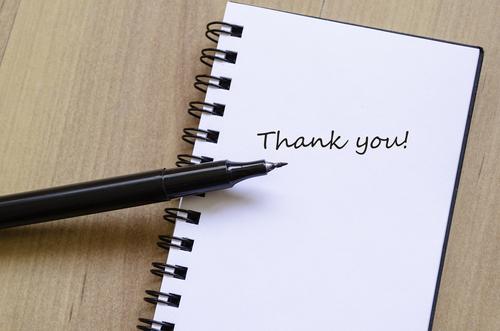Email or Snail Mail?
Etiquette experts extol the merits of handwritten notes. Even a brief missive can make a real difference when a manager is on the fence, Diane Gottsman, author of Pearls of Polish and owner of The Protocol School of Texas, said in an interview. A handwritten note shows sincerity, interest and your willingness to go the extra mile—and it won’t end up in a junk-mail folder. But there’s also some downside: Snail mail is too slow for today’s digital world, and a handwritten note may not be appropriate for a manager who wears shorts and flip-flops to work. The solution? Always send a thank-you email within 24 hours, followed by a handwritten version if the latter fits the manager’s style and culture. (In an ideal scenario, your handwritten note will arrive a few days later and prod the manager if he or she hasn’t made a hiring decision.) Can you send a thank-you note by texting or social media? No. Can you send a thank-you note as a group email to multiple people? Absolutely not—make sure to personalize the content of each note.Upload Your ResumeEmployers want candidates like you. Upload your resume. Show them you're awesome.
Keep It Short
Don’t exceed two to three short paragraphs, and always start your email with “Dear” instead of “Hi” or “Hey.” After all, you don’t have a personal relationship with the manager, noted Jacqueline Whitmore, a business etiquette expert based in Palm Beach, Fla. and author of Poised for Success. A thank-you note is a form of professional communication. First, thank the manager for his or her time. Then showcase your listening and memory skills by referencing a key point from the job interview. For instance:Thank you for meeting with me and answering my questions about your project management position. I really enjoyed our discussion about the pros and cons of Waterfall and Agile. I agree with your conclusion that a hybrid approach is usually best. Especially, in a diverse project environment like yours.After that, briefly recap your most relevant skills and experience and how you plan to use them to solve the company’s most pressing problem, such as improving the user experience or creating efficiencies. Include a link to a relevant white paper you authored or a coding sample, but stick to one or two examples at most. “The purpose of the note is to express thanks, not revisit the entire interview,” Whitmore said. Finally, reiterate your interest in the position and indicate when you’ll follow up. The manager may skim your letter, but will probably notice a call to action such as a follow-up date.
Customize Your Message
Always customize the content of your note, including its tone and style, for your audience. For example, you should use a formal, business-y voice if you’re trying to break into a Wall Street investment bank, major tech consulting firm or a Fortune 500 company. More informal language might be appropriate for a small company with a relaxed or casual environment, but never use slang, text shortcuts, or terms such as “bro” or “dude.” Check out these examples of formal and informal language if you’re in doubt. Matching the interviewer’s style is always your best bet; the most effective thank-you notes are personal yet professional. Referencing the company’s acronyms and catch phrases, or mentioning its core technology or projects, can position you as an insider and give you a strategic advantage over other candidates. Things like cultural fit, passion and problem-solving abilities often trump technical skills when IT managers are weighing several candidates. If writing thank-you notes isn’t your strong suit, review some samples online or start with a template. Just be sure to customize the phrasing and content so it resonates with the IT manager. Remember, sending a canned and insincere thank you is worse than not sending one at all.Related Articles
- Tips for Surviving a Hostile Job Interview
- 10 Simple Ways to Mess Up a Job Interview
- Daily Tip: Strong Verbs for Your Resume



